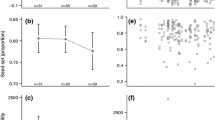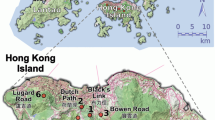Abstract
Human activities are fragmenting forests and woodlands worldwide, but the impact of reduced tree population densities on pollen transfer in wind-pollinated trees is poorly understood. In a 4-year study, we evaluated relationships among stand density, pollen availability, and seed production in a thinned and fragmented population of blue oak (Quercus douglasii). Geographic coordinates were established and flowering interval determined for 100 contiguous trees. The number of neighboring trees within 60 m that released pollen during each tree's flowering period was calculated and relationships with acorn production explored using multiple regression. We evaluated the effects of female flower production, average temperature, and relative humidity during the pollination period, and number of pollen-producing neighbors on individual trees' acorn production. All factors except temperature were significant in at least one of the years of our study, but the combination of factors influencing acorn production varied among years. In 1996, a year of large acorn crop size, acorn production was significantly positively associated with number of neighboring pollen producers and density of female flowers. In 1997, 1998, and 1999, many trees produced few or no acorns, and significant associations between number of pollen-producing neighbors and acorn production were only apparent among moderately to highly reproductive trees. Acorn production by these reproductive trees in 1997 was significantly positively associated with number of neighboring pollen producers and significantly negatively associated with average relative humidity during the pollination period. In 1998, no analysis was possible, because too few trees produced a moderate to large acorn crop. Only density of female flowers was significantly associated with acorn production of moderately to highly reproductive trees in 1999. The effect of spatial scale was also investigated by conducting analyses with pollen producers counted in radii ranging from 30 m to 80 m. The association between number of pollen-producing neighbors and acorn production was strongest when neighborhood sizes of 60 m or larger were considered. Our results suggest that fragmentation and thinning of blue oak woodlands may reduce pollen availability and limit reproduction in this wind-pollinated species.
Similar content being viewed by others
Author information
Authors and Affiliations
Additional information
Electronic Publication
Rights and permissions
About this article
Cite this article
Knapp, E., Goedde, M. & Rice, K. Pollen-limited reproduction in blue oak: implications for wind pollination in fragmented populations. Oecologia 128, 48–55 (2001). https://doi.org/10.1007/s004420000623
Received:
Accepted:
Published:
Issue Date:
DOI: https://doi.org/10.1007/s004420000623




